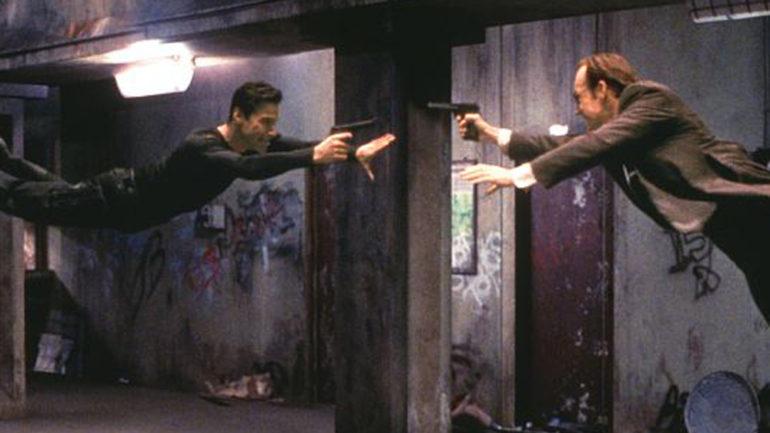‘The Matrix’ 20 Years Later: The Artificial Intelligence Lives in Us (Column)
By Owen Gleiberman
LOS ANGELES (Variety.com) – The term “artificial intelligence” was coined in 1956, but one way or another it has been the subject of just about every great science-fiction movie, from “Metropolis” to “Frankenstein,” from the paranoid fables of the ’50s (about brainy robots and aliens with giant noggins who were like “advanced” versions of ourselves) to “2001: A Space Odyssey,” in which HAL, the computer who talks like a wounded therapy patient, displays the anger and ego of a jilted human being. And by the late ’70s and early ’80s, the Machines Who Could Think were really taking over. “Alien” featured a technologically evolved monster with the metallic jaws, the helmet head, and the relentlessness of a demonic thresher, the most sympathetic character in “Blade Runner” was a replicant, and “The Terminator” gave us a dystopia ruled by the machines, featuring a weaponized badass who was the ultimate programmed destroyer.
But in “The Matrix,” the landmark of liquid-action sci-fi released 20 years ago today, the artificial intelligence comes at us in a uniquely teasing, forward-tilting, who’s-that-in-the-mirror way. The movie is about a computer-company office drone, played with pinpoint charisma by Keanu Reeves, who gets tugged out of his existence by a rebel underground that unplugs him from .
And what is the Matrix?
You could say, as some did at the time of the film’s release, that it’s a fantasy version of the Internet. You could say that it’s the collective cosmos of advertising images designed to seduce and hypnotize us and keep us in line. You could say that it’s the mythical promise of American middle-class consumer society — the security and prosperousness, the illusion of untouchability — or, in fact, that it’s the very fabric of that life.
The Matrix is all those things.
But it adds up to this: Whatever force it is (the corporation, the government, the machines) that has created and promulgated this ominous mirage of the everyday, this castle-in-the-air version of our identity and existence, the ones who ultimately allow it to succeed are the ones who are willing to believe in it. The Matrix is a false reality that exists because the people it enslaves have colluded in its power. Reeves’ Neo has to shake himself free of the Matrix, but what he really has to unplug from is himself. In “The Matrix,” we’ve seen the enemy and it is us — or, rather, it’s our ability to live inside a narcotic capitalist dream world. That’s the movie’s playful power.
And it’s expressed, most teasingly and provocatively, in the film’s spectacular central contradiction: “The Matrix” is a film of ideas — a tale of perception and reality, a cross between Philip K. Dick and “Alice in Wonderland” — that resolves itself as a visionary balletic action film. When I first saw the movie in 1999, that contradiction bothered me. I’d gotten all caught up in the film’s gelatinous brainpan imagery and head-trip themes, so when Reeves, in his long black coat and sunglasses, began to skitter up walls and dodge bullets at the speed at which they were moving, I thought, “Yes, very cool. But what does that have to do with what the movie is saying?”
The second time I saw “The Matrix,” I was ready for the turn it took, from metaphysics to kinesthetics, from heady parable to kung fu, and it bothered me less. And the more times I saw it, the more I accepted that the two facets of it were less an uneasy blend than, simply, the gestalt of what the movie is: a sci-fi geek-out that climaxes and resolves itself in blockbuster dazzle.
But now, when I watch “The Matrix,” I realize that it’s actually a perfect fusion of form and theme. If there’s anything, in the last 30 or 40 years, that’s kept our society mesmerized, it’s our addiction to the bedazzling unreality of cinematic action. It’s a craving that has only escalated in the digital age, because the definition of the digital era — and it’s one of the things that makes “The Matrix,” though not the greatest film of 1999, still the quintessential film of 1999 — is that when you’re watching a movie, anything (literally anything) can now happen. Gravity no longer rules, and neither does the earthbound quality of the sets, or even the age of the actors. Space and matter flow and dissolve. It’s a landscape of the imagination, a universe without limits, guided only by the human power to manipulate images. And it’s become a realm that more and more of us, raised on video games and comic-book movies, don’t just experience but occupy.
And that, in its way, is what “The Matrix” is about, never more so than when the movie is hypnotizing us with its revolutionary feats of propulsive transformation. To watch “The Matrix” is to understand something essential about the world of illusion we’re living in — and then, with more fury and devotion than ever, to plug right back into it.

